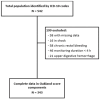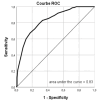External Validation of the Oakland Score for Acute Lower Gastrointestinal Bleeding
- PMID: 38686245
- PMCID: PMC11056811
- DOI: 10.7759/cureus.57264
External Validation of the Oakland Score for Acute Lower Gastrointestinal Bleeding
Abstract
Introduction Acute lower gastrointestinal bleeding (LGIB) presents challenges in emergency settings, with incidence influenced by demographic shifts and anticoagulant usage. The Oakland score aids in risk stratification for safe discharge based on clinical and laboratory parameters. However, external validation remains limited. Methods This study validated the Oakland score in a French cohort of patients with acute LGIB and assessed the discriminatory value of the score using the area under the curve (AUC) and then its sensitivity and specificity. Results A retrospective examination of 343 patient records that satisfied the inclusion criteria showed a median score of 14 points and good discriminatory capacity (area under the receiver operating characteristic (AUROC) curve: 0.83). There was low sensitivity (20.9%) for safe discharge but good specificity (98.5%) when using an 8-point threshold. With a 9-point threshold, the sensitivity was increased to 36.5%, while the specificity remained at 95%. Conclusion Identifying low-risk LGIB patients is accomplished without sacrificing sensitivity by increasing the Oakland score threshold to 9 points. This modification improves patient safety and resource allocation in the emergency room and has been verified by other large series. For wider implementation, additional validation and long-term outcome evaluations are required.
Keywords: emergency department; external validation; gastrointestinal bleeding; oakland score; risk stratification; safe discharge.
Copyright © 2024, Raqi et al.
Conflict of interest statement
The authors have declared that no competing interests exist.
Figures
References
-
- Time trends and impact of upper and lower gastrointestinal bleeding and perforation in clinical practice. Lanas A, García-Rodríguez LA, Polo-Tomás M, et al. Am J Gastroenterol. 2009;104:1633–1641. - PubMed
-
- Lower gastrointestinal bleeding: incidence, etiology, and outcomes in a population-based setting. Hreinsson JP, Gumundsson S, Kalaitzakis E, Björnsson ES. Eur J Gastroenterol Hepatol. 2013;25:37–43. - PubMed
-
- Review article: the management of lower gastrointestinal bleeding. Farrell JJ, Friedman LS. Aliment Pharmacol Ther. 2005;21:1281–1298. - PubMed
-
- Endoscopic management of acute lower gastrointestinal bleeding. Wong Kee Song LM, Baron TH. Am J Gastroenterol. 2008;103:1881–1887. - PubMed
LinkOut - more resources
Full Text Sources



